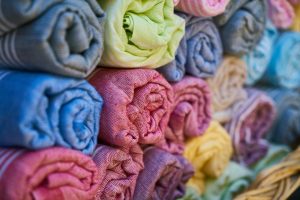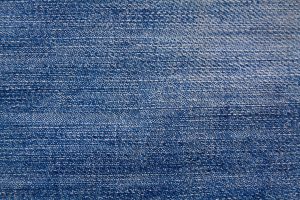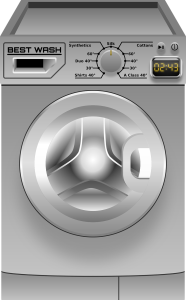5 Preparing the Fabric
Sheri Deaton
Preparing the Fabric
I’ve bought my fabric… Now what?
Once you have read the pattern envelope and purchased the suggested fabric for the project you are wanting to create, it is time to prepare the fabric. What you do to the fabric will vary depending on the fabric itself.
- If the fabric is off-grain, it may need to be straightened.
- If the fabric is not already preshrunk, it needs to be. Failing to do this will cause your garment to not fit properly after being created, washed, and dried for the first time.

What do we mean, by “off grain”?
Fabrics that are woven or knitted together have direction or grain. This is determined by the position of the yarns and fibers in the fabric (Westfall, 2013). In woven fabrics, the grain must be straight. Pattern pieces should be cut out in the same direction as the grain so that they hang properly on the body. Not checking for straight grain is a great way to create a project that is a little “wonky” and does not fit or fall the way you had desired. Let’s unpack a few essential terms before we go further.

How do I know if the fabric is on grain?
Fabric that is on-grain has crosswise and lengthwise threads at right angles to each other. To see if your fabric is straight of grain, straighten the cut ends of the fabric, oftentimes called raw edges. Watch the following videos to learn more.
| How to Cut a Straight Edge |  |
| How to Find Grain Lines on Scraps of Fabric |  |
| How to Straighten a Fabric that is Off Grain |  |
Preshrinking Fabric
The best way to ensure that your garment is not going to be too small once you have made it is to preshrink the fabric. To effectively do this, follow the launder suggestions provided by the manufacturer for the fabric you have purchased. I like to wash my new fabrics by themselves to ensure they do not bleed on any other laundry.
Some fabrics will not require preshrinking. In general, preshrink any fabric unless the label states it will not shrink. I always recommend prewashing the fabric even for fabrics that do not require preshrinking. This helps get rid of any finishes that could make the needle stick or the machine skip stitches (Deaton, 2021). Also, who knows how many hands have touched this fabric before you?

Laundry Language
Have you ever accidentally shrunk your favorite shirt or pair of jeans? Have you ever ruined a garment by using an iron at too high of a setting? These situations happen far too often, resulting in damaged garments that may be beyond repair.
Knowing how to care for the fabric you have purchased is critical. Some fabrics are made of manufactured or synthetic fibers, while others are made from natural fibers. The origin of the fiber that the fabric is made of impacts how the fabric is laundered.
- Natural fibers come from nature, with an origin of either plants or animals. Animal-based fibers include silk and wool. Plant-based natural fibers include cotton, linen, and jute. Natural fibers tend to be absorbent, eco-friendly, and durable (Natural vs. synthetic fibers: What’s the difference? , 2021).
- Synthetic or manufactured fibers are man-made, created from a variety of chemical compounds. Each fiber has its unique characteristics, but synthetic fibers tend to be cheaper, resist stains, and can be waterproof or water-resistant, depending on the finish added to the fiber or the chemicals used in the creation of the fiber (Natural vs. synthetic fibers: What’s the difference? , 2021).
Students need opportunities and time to practice reading the laundry symbols to extend their learning and prepare them for laundering garments once they are created. Check out this free Laundry Symbols File Folder Printable shared on Teachers Pay Teachers.
Hemming it Up
The more you know about fabric, the better equipped you will be to launder it correctly. Knowing the origin of the fabric and how it will respond to stains, heat, and solutions is critical for the correct care of the fabric for the life of the garment or home goods. Take the time to get to know the fabric you are working with considering its unique characteristics before and after you invest your resources.
Lastly, before you pin a pattern piece to the fabric you have purchased, make sure that it is on grain and pre-shrunk. These two steps will save you an enormous amount of frustration and tears!
Resources
| Resources | QR Codes |
| Lesson Planet Lesson Plans |  |
| Laundry Symbols File Folder Printable |  |
References
Deaton, S. (2021). Teaching Apparel Production. Presentation.
Natural vs. synthetic fibers: What’s the difference? MasterClass. (2021, August 26). Retrieved March 31, 2023, from https://www.masterclass.com/articles/natural-vs-synthetic-fibers
Westfall, M. (2013). Successful sewing. The Goodheart-Willcox Company, Inc.


